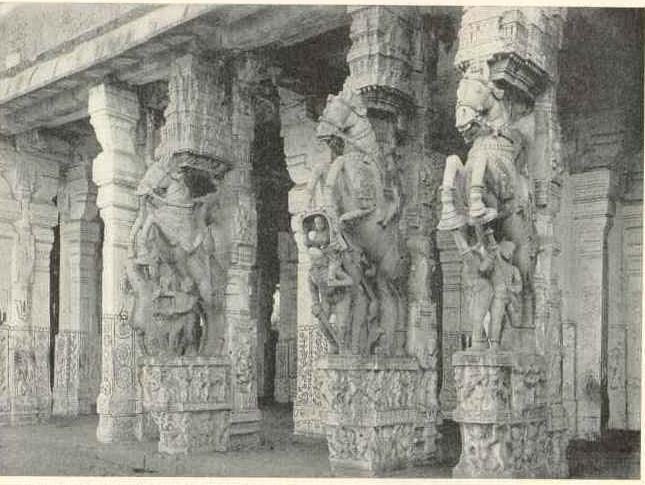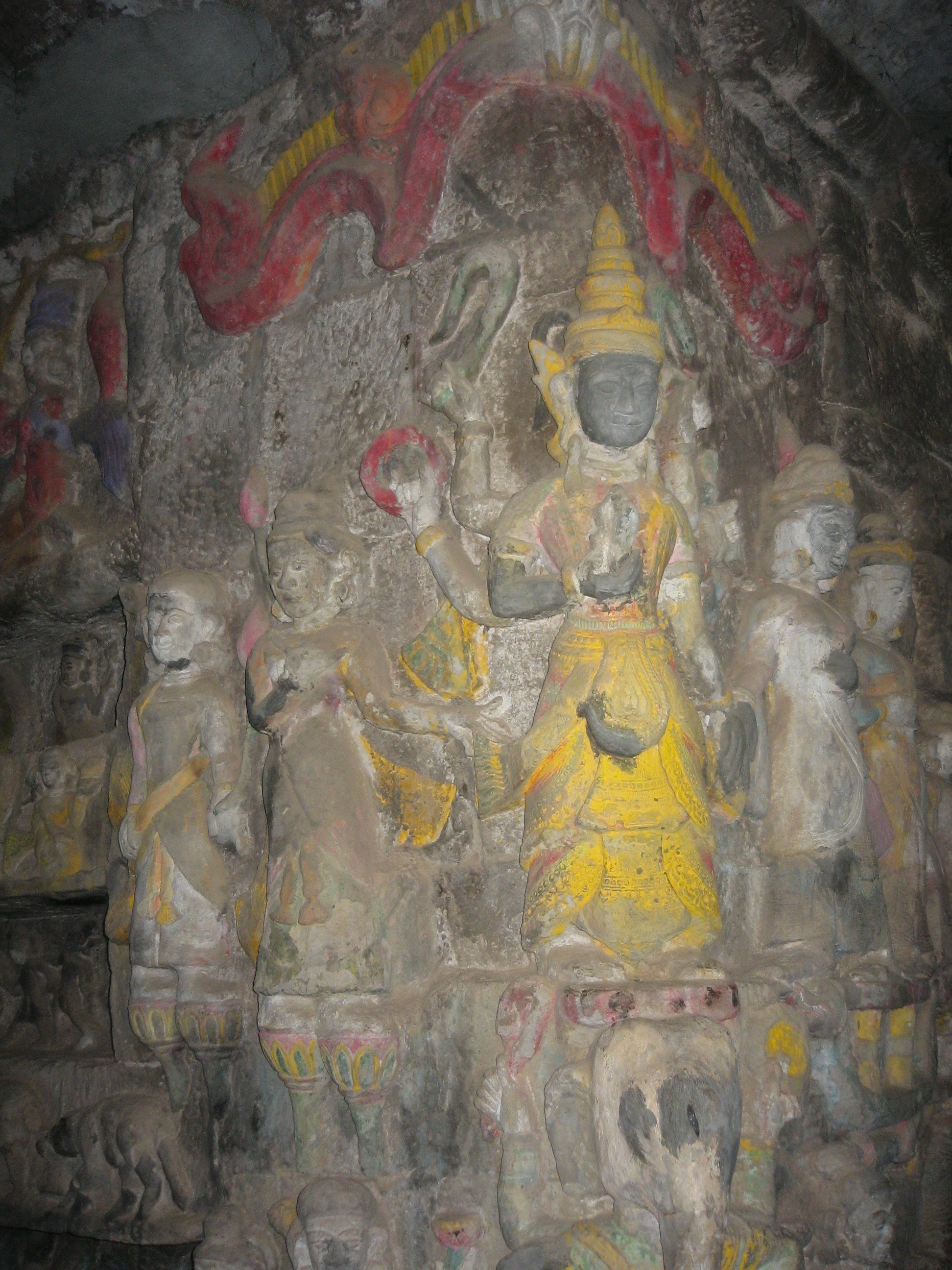|
Gingee Nayaks
The Nayaks of Gingee (Senji) were rulers of the Gingee principality of Tamil Nadu between 16th to 18th century CE. They were subordinates of the imperial Vijayanagara emperors, and were appointed as provincial governors by the Vijayanagar Emperor who divided the Tamil country into three Nayakships viz., Madurai, Tanjore and Gingee. Later, after the fall of the Vijayanagara's Tuluva dynasty, the Gingee rulers declared independence. While they ruled independently, they were sometimes at war with the Tanjore neighbors and the Vijayanagara overlords later based in Vellore and Chandragiri. The Nayaka Rulers clan The Gingee Nayak line was established by Tubaki (aka Tupakula) Krishnappa Nayaka, the son of Koneri Nayaka and grandnephew of Achyutappa Nayaka. Sanjay Subrahmanyam and Brennig provide the following details on Achyutappa Nayak: Some of the Nayakas in the Gingee line were: # Krishnappa Nayaka (1509–1521) # Chennappa Nayaka # Gangama Nayaka # Venkata Krishnappa Nayaka # V ... [...More Info...] [...Related Items...] OR: [Wikipedia] [Google] [Baidu] |
Gingee Fort
Gingee Fort or Senji Fort (also known as Chenji, Chanchi, Jinji or Senchi) in Tamil Nadu, India is one of the surviving forts in Tamil Nadu, India. It lies in Villupuram District, from the state capital, Chennai, and is close to the Union Territory of Puducherry. The site is so fortified that Shivaji, the Maratha king, ranked it as the "most impregnable fortress in India", and it was called the "Troy of the East" by the British. The nearest town with a railway station is Tindivanam and the nearest airport is Chennai (Madras), located away. Originally built by Ananta Kon of the Konar dynasty around 1190 AD and later fortified by Krishna Konar, it was later modified in the 13th century to elevate it to the status of an unbreachable citadel to protect the small town of saenji. It was also the headquarters domination in northern Tamil Nadu. The fort was built as a strategic place of fending off any invading armies. As per one account, the fort was further fortified during the 15� ... [...More Info...] [...Related Items...] OR: [Wikipedia] [Google] [Baidu] |
Puducherry (union Territory)
Puducherry (), also known as Pondicherry () or Pondichéry, is a union territory of India, consisting of four small geographically unconnected districts. It was formed out of four territories of former French India, namely Pondichéry (Pondicherry; now Puducherry), Karikal (Karaikal), Mahé and Yanaon (now Yanam), excluding Chandannagar (Chandernagore), and it is named after the largest district, Puducherry, which was also the capital of French India. Historically known as Pondicherry (), the territory changed its official name to Puducherry on 20 September 2006. The Union Territory of Puducherry lies in the southern part of the Indian Peninsula. The areas of Puducherry district and Karaikal district are bound by the state of Tamil Nadu, while Yanam district and Mahé district are enclosed by the states of Andhra Pradesh and Kerala, respectively. Puducherry is the 29th most populous of the 36 states and union territories of India, and the third most densely populated ... [...More Info...] [...Related Items...] OR: [Wikipedia] [Google] [Baidu] |
Thanjavur Nayak Kingdom
The Thanjavur Nayak kingdom or Thanjavur Nayak dynasty were the rulers of Thanjavur in the 15th and 17th centuries. The Nayaks of the Balija social group, were originally appointed as provincial governors by the Vijayanagara Emperor in the 15th century, who divided the territory into Nayak kingdoms which were Madurai, Tanjore, Gingee and Kalahasthi. In the mid 15th century they became an independent kingdom, although they continued their alliance with the Vijayanagara Empire. The Thanjavur Nayaks were notable for their patronage of literature and the arts. A translation from '' Raghunathabhyudayam (p. 284)'', says this about Timma Nayak the father of Sevappa Nayak, the founder of the Tanjore Nayak in line: ''In the sathria caste born from the feet of Vishnu was born a king called Timma Nayak''.''Nayaks of Tanjore'', by V. Vriddhagirisan, p.26 The ''Mannaru'' (Vishnu) of the Mannargudi temple was their ''kula daivam'' (family deity). Origins of Nayak rule With the demise of the ... [...More Info...] [...Related Items...] OR: [Wikipedia] [Google] [Baidu] |
List Of Arakan Kings
The following is a list of monarchs of Arakan, starting from the Lemro period. For monarchs from earlier periods, see List of early and legendary monarchs of Burma. Lemro (1018–1430) Unless otherwise noted, the regnal dates in this section are abbreviated to the first Western calendar year only although the Burmese calendar straddles the Western calendar. For example, the start of King Khittathin's reign, 380 ME (26 March 1018 to 25 March 1019 CE), is shown here only as 1018 (instead of 1018/19). Pyinsa(1018–1103) Parein(1103–1167) Hkrit (1167–1180) Nyeinjara Toungoo (1180–1237) Launggyet (1251–1406) Interregnum (1406–1429) North Arakan Sandoway (Thandwe) Mrauk-U (1429–1785) The reign dates are per the Arakanese chronicle '' Rakhine Razawin Thit'' (Sandamala Linkara Vol. 2 1931), converted into Western dates using (Eade 1989). (Some Arakanese chronicles state the foundation of the kingdom a year later, 1430. Moreover, the end of the kingd ... [...More Info...] [...Related Items...] OR: [Wikipedia] [Google] [Baidu] |
Cuddalore
Cuddalore, also spelt as Kadalur (), is the city and headquarters of the Cuddalore District in the Indian state of Tamil Nadu. Situated south of Chennai, Cuddalore was an important port during the British Raj. While the early history of Cuddalore remains unclear, the city first rose to prominence during Pallavas and Medieval Cholas' reign. After the fall of Cholas, the town was ruled by various dynasties like Pandyas, Vijayanagar Empire, Madurai Nayaks, Thanjavur Nayaks, Thanjavur Marathas, Tipu Sultan, French and the British Empire. Cuddalore was the scene of the Seven Years' War and the Battle of Cuddalore in 1758 between the French and British. It has been a part of independent India since 1947. During the 2004 Indian Ocean earthquake, and the subsequent tsunamis generated, Cuddalore was one of the affected towns, with 572 casualties. Apart from fishing and port-related industries, Cuddalore houses chemical, pharmacological and energy industries in SIPCOT, an industria ... [...More Info...] [...Related Items...] OR: [Wikipedia] [Google] [Baidu] |
Alf Hiltebeitel
Alfred John Hiltebeitel (born 1942) is Columbian Professor of Religion, History, and Human Sciences at George Washington University in Washington DC, USA. His academic specialism is in ancient Sanskrit epics such as the ''Mahabharata'' and ''Ramayana'', together with Indian religious tradition and folklore. Background Hiltebeitel was awarded a B.A. degree from Haverford College, where he majored in religion and minored in English (1959-1963). He attended the University of Chicago Divinity School, where he obtained an M.A. (1966) and a Ph.D. (1973) in the History of Religions. His doctoral thesis is entitled ''Gods, Heroes, and Krsna: A Study of the Mahabharata in relation to Indian and Indo-European Symbolisms''. Hiltebeitel was an editorial assistant for Seabury Press in New York City during 1963–1964, and between 1967-1968 he held a similar post with the '' History of Religions Journal''. He was appointed an Assistant Professor in Religion at George Washington University (GW ... [...More Info...] [...Related Items...] OR: [Wikipedia] [Google] [Baidu] |
Burton Stein
Burton Stein (1926 – April 26, 1996) was an American historian, whose area of specialization was India. Life and career Stein was born and grew up in Chicago, Illinois and served in the Second World War, before commencing tertiary study at the now disused Navy Pier facility that in 1945 was the Chicago campus of the University of Illinois. Stein was an unusual case in that he never completed a bachelor's degree. He was admitted directly into a Master of Arts program at the University of Chicago, finishing his masters in 1954 under the supervision of Robert Crane. He wrote his Ph.D. dissertation in 1957 on the economic functions of South India's medieval Tirupati temple. Upon the completion of his PhD, Stein was appointed to a teaching post at the University of Minnesota, where he stayed until the end of 1965. He then married the author Dorothy Stein and moved to the University of Hawaii where he stayed for 17 years until 1983. He held visiting professorships at the University o ... [...More Info...] [...Related Items...] OR: [Wikipedia] [Google] [Baidu] |
Krishnadevaraya
Krishnadevaraya (17 January 1471 – 17 October 1529) was an emperor of the Vijayanagara Empire, also known as the Karnata Empire, reigning from 1509 to 1529. He was the third monarch of the Tuluva dynasty, and is considered to be one of the greatest rulers in Indian history. He ruled the largest empire in India after the decline of the Delhi Sultanate.Keay, John, India: A History, New York: Harper Collins, 2000, p.302 Presiding over the empire at its zenith, he is regarded as an icon by many Indians. Krishnadevaraya earned the titles ''Karnatakaratna Simhasanadeeshwara'' (lit. "Lord of the Jewelled Throne of Karnataka"), ''Yavana Rajya Pratistapanacharya'' (lit. "Establishment of the King to Bahmani Throne"), ''Kannada Rajya Rama Ramana'' (lit. "Lord of the Kannada Empire), ''Andhra Bhoja'' (lit. "Scholar of Andhra"), ''Gaubrahmana Pratipalaka'' (lit. "Protector of Brahmins and Cows") and ''Mooru Rayara Ganda'' (lit. "Lord of Three Kings"). He became the dominant ruler of the ... [...More Info...] [...Related Items...] OR: [Wikipedia] [Google] [Baidu] |
Aravidu Dynasty
The Aravidu Dynasty was the fourth and last Hindu dynasty of Vijayanagara Empire in South India. Its founder was Tirumala Deva Raya, whose brother Rama Raya had been the masterful regent of the last ruler of the previous dynasty. Rama Raya's death at the Battle of Talikota in 1565 led to the subsequent destruction of Vijayanagar by the combined forces of the Muslim states of the Deccan. The Aravidu family claimed to be Kshatriyas and were based in Andhra region They claimed to belong to the Atreya gotra and traced their lineage to Rajaraja Narendra. List of rulers The main rulers of the Aravidu dynasty were: *Aliya Rama Raya (1542–1565 CE), first ruler *Tirumala Deva Raya (1565–1572 CE) *Sriranga Deva Raya (Sriranga I) (1572–1586 CE) *Venkatapati Deva Raya (Venkata II) (1586–1614 CE) *Sriranga II (1614–1617 CE) *Rama Deva Raya (1617–1632 CE) *Peda Venkata Raya (Venkata III) (1632–1642 CE) *Sriranga III (1642–1652 CE), last ruler of dynasty and empire See also ... [...More Info...] [...Related Items...] OR: [Wikipedia] [Google] [Baidu] |

.jpg)



